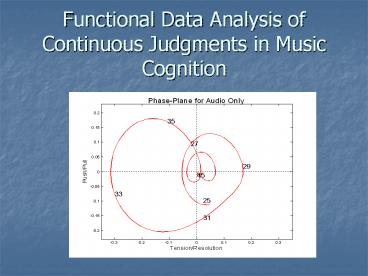Functional Data Analysis of Continuous Judgments in Music Cognition - PowerPoint PPT Presentation
Title:
Functional Data Analysis of Continuous Judgments in Music Cognition
Description:
Functional Data Analysis of Continuous Judgments in Music Cognition Gesture in Musical Performance What role do a musician s gestures play in a performance? – PowerPoint PPT presentation
Number of Views:60
Avg rating:3.0/5.0
Title: Functional Data Analysis of Continuous Judgments in Music Cognition
1
Functional Data Analysis of Continuous Judgments
in Music Cognition
2
Gesture in Musical Performance
- What role do a musicians gestures play in a
performance? - Do they convey emotion?
- Do gestures convey the same things as does the
music? - Popular study in field of music psychology
- Data on listeners emotions are collected in
real-time - With a real-time Optotrak slider, which
- Measures location of the slider 10 times per
second.
Continuous Judgments of Music
3
The Tension Gesture Experiment
- Musical performance recorded on video
- Stravinskys 2nd Piece for Solo Clarinet
- 30 musically-trained participants either
- Watched Listened to the recording (Natural)
- Watched the silent recording (Video Only), or
- Listened to the recording (Audio Only).
- And reported their continuous level of tension
emotion.
4
The Data
- Vectors of length 800
- 10 Audio Only, 10 Video Only, 10 Audio
Video - Scaled to 0,1 interval
5
The Functional Objects
- 150 order 6 B-splines, using FDA software in
Matlab. - Then smoothed.
6
Functional Principal Components Analysis
- 25 s 65 s crucial separation
- Effect of amplification / attenuation how
strong are the changes of emotion?
7
Functional Linear Model
Emotion(t) µ(t) ß0(t)AudRemoved
ß1(t)VidRemoved e(t)
8
Functional Linear Model
Emotion(t) µ(t) ß0(t)AudRemoved
ß1(t)VidRemoved e(t)
9
Derivatives describe music dynamics Tension
- These judgments are really measures of musical
emotion. - Tension/Resolution is rate of change of emotion
(velocity). - When emotion is rapidly increasing, music has
strong tension. - When emotion is rapidly decreasing, music has
strong resolution.
10
Derivatives describe music dynamics Force/Release
- Force/Release is rate of change of tension
(acceleration). - When tension is rapidly increasing, we feel a
musical force. - When tension is rapidly decreasing, we feel a
musical release. - When both derivatives are near zero, music is
inert (the new age/massage music effect).
11
Phase-Plane Plots
- Can examine dynamics with plot of acceleration vs
velocity. - Purely harmonic behavior gives a circle.
- The larger the radius, the more musical energy
transfer.
12
(No Transcript)
13
(No Transcript)
14
(No Transcript)
15
- 25 33 s
- AUDIO high volume, note density, and pitch end
of musical phrase - tension then strong resolution big energy
transfer - VIDEO routine gestures then dramatic flourish
- low tension and small resolution moderate pull
with flourish small energy transfer - 33 65 s
- AUDIO decrease in volume (mezzo forte to
pianissimo), note density, and pitch - continued resolution push from new phrase back
to inertness - VIDEO eyebrow and body movements
- push from new phrase, moderate tension from
movements
16
What have we learned?
- New applications
- PCA as exploration
- Derivatives have physical (and scientific)
meaning - Phase-Plane plots highlight relationships

